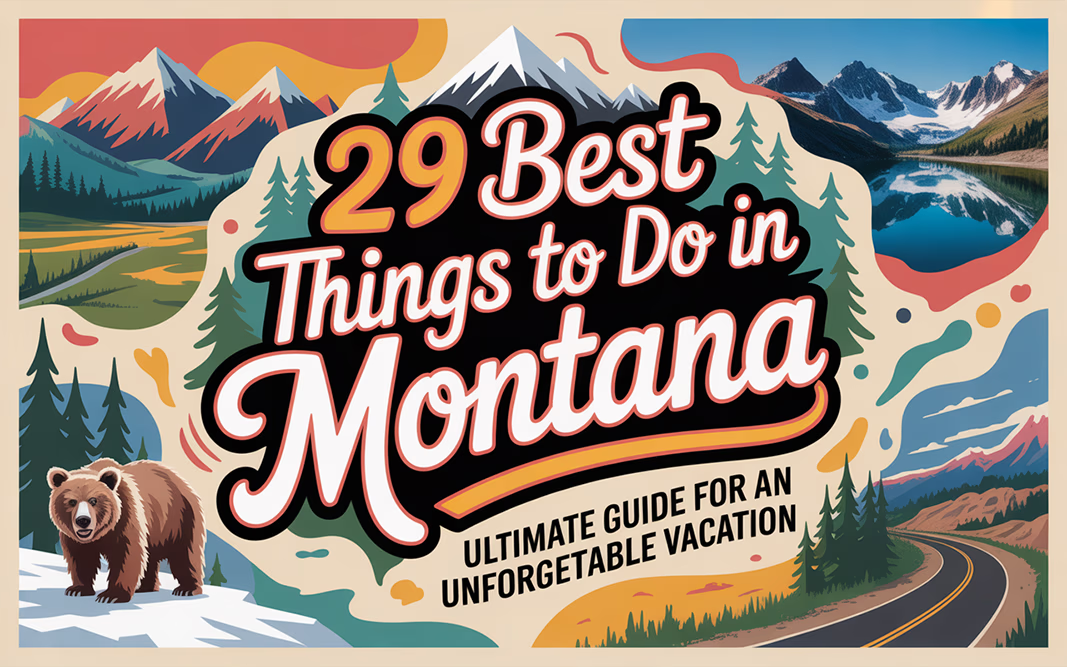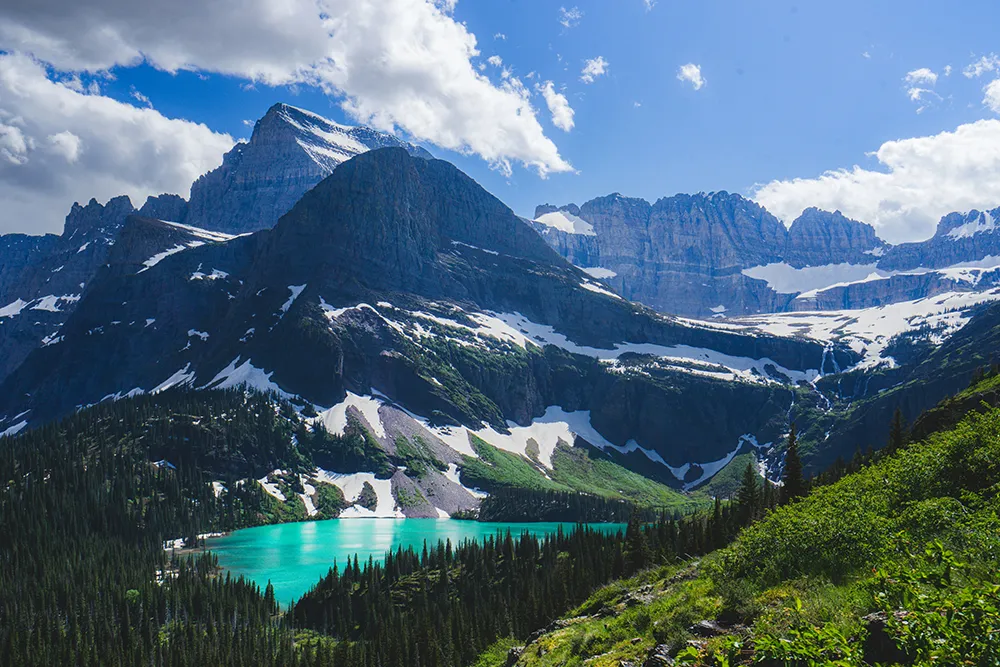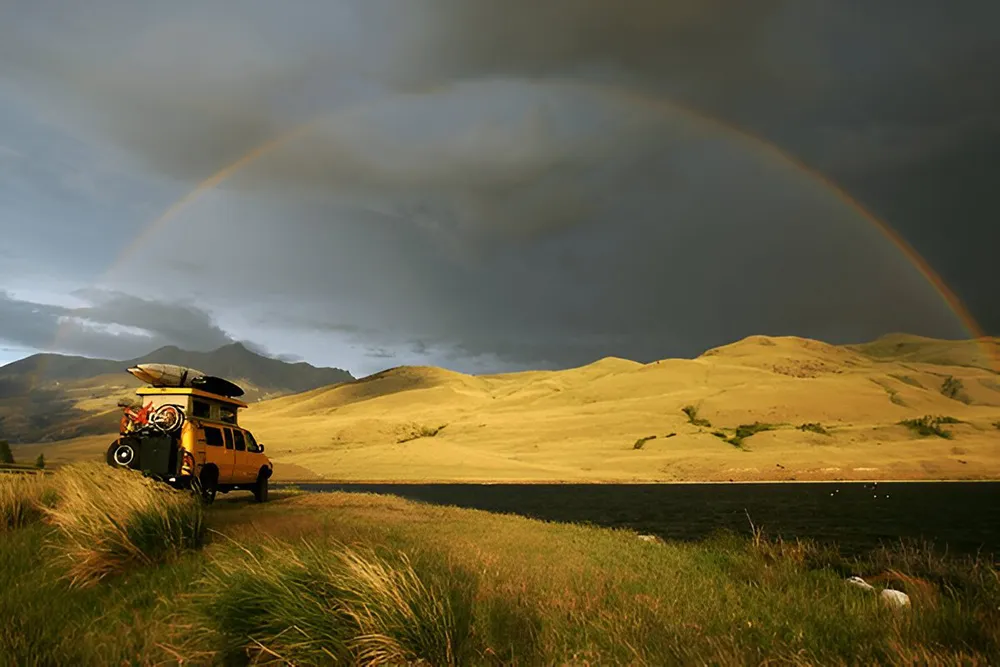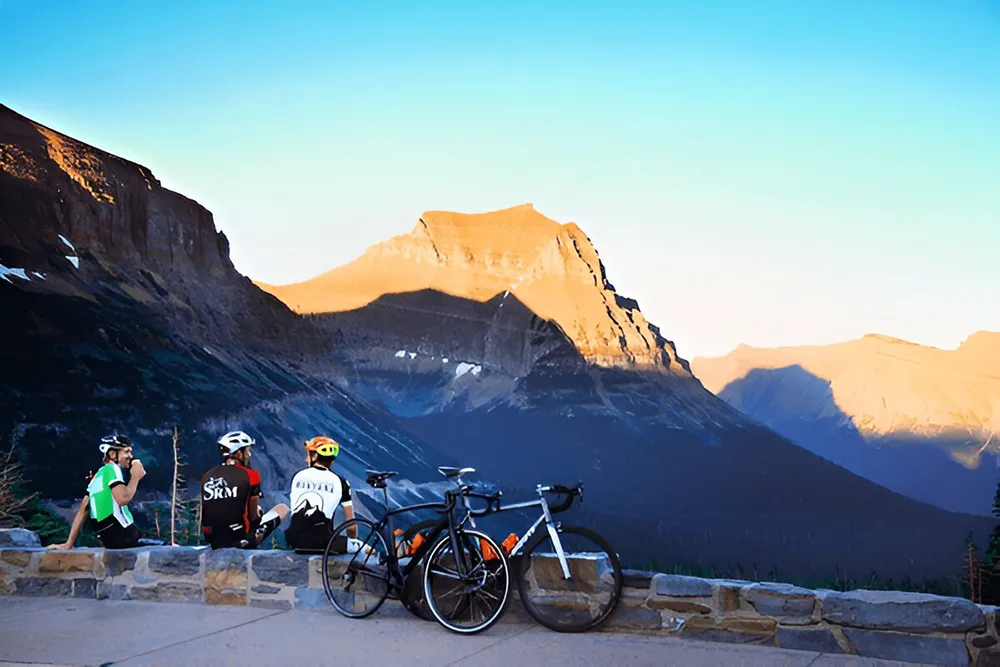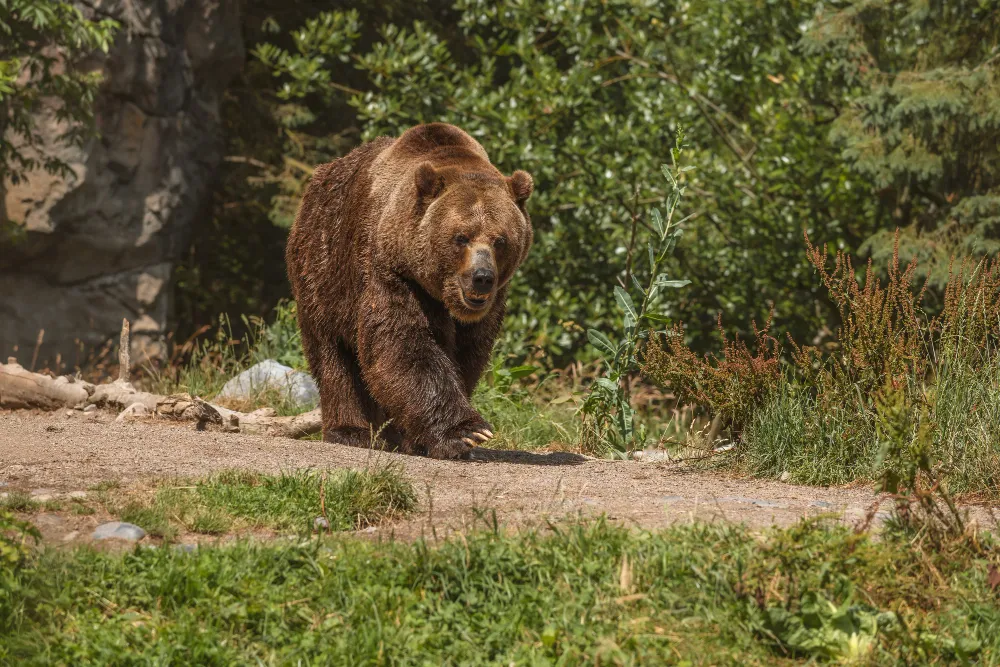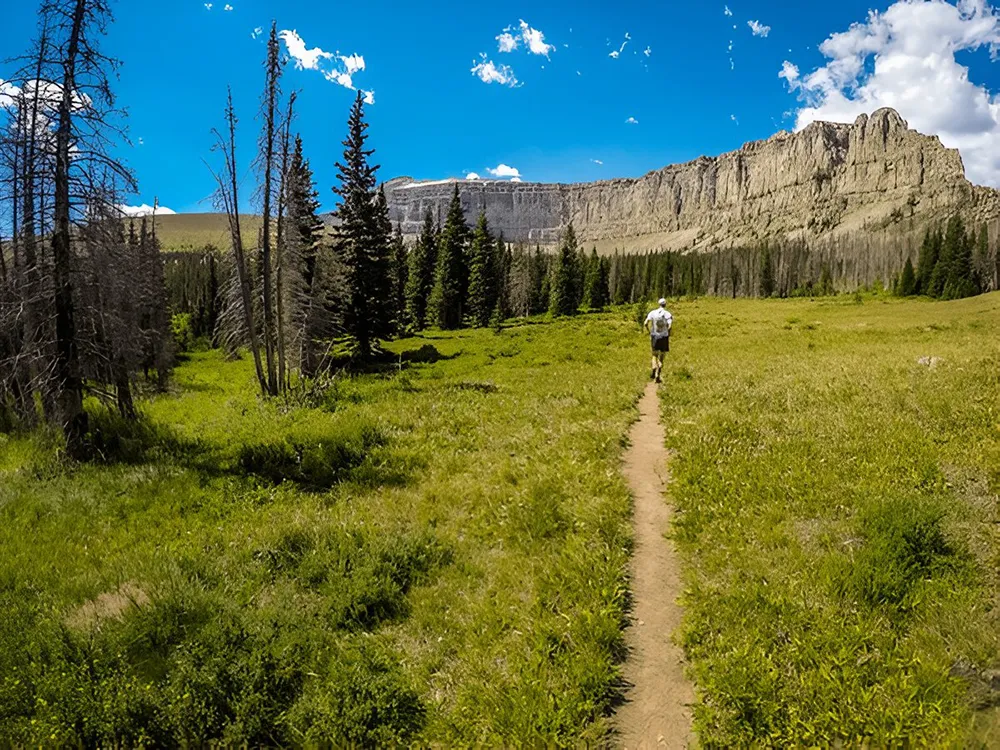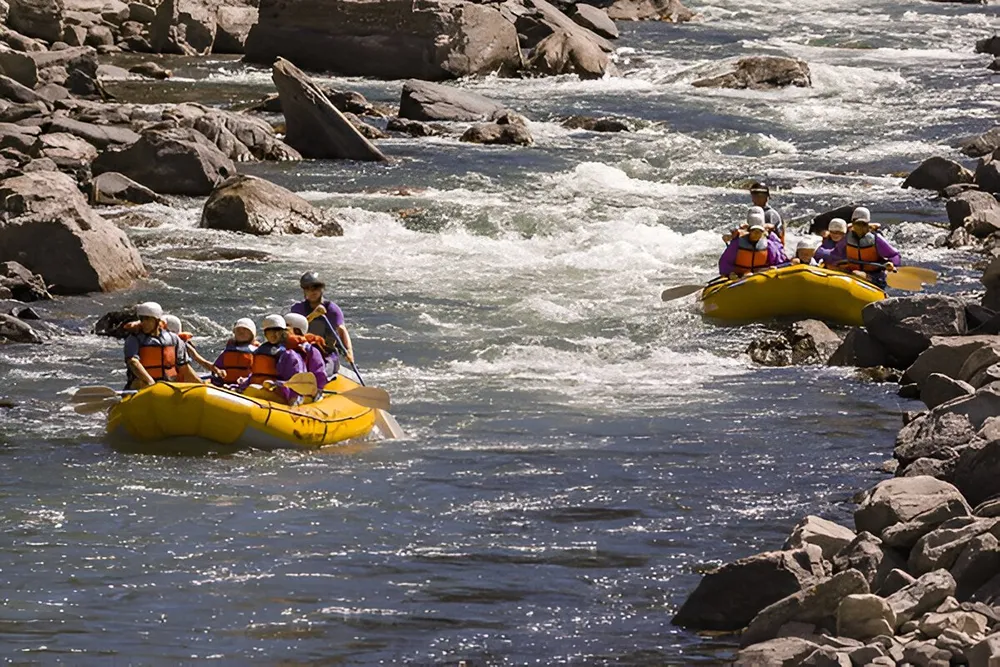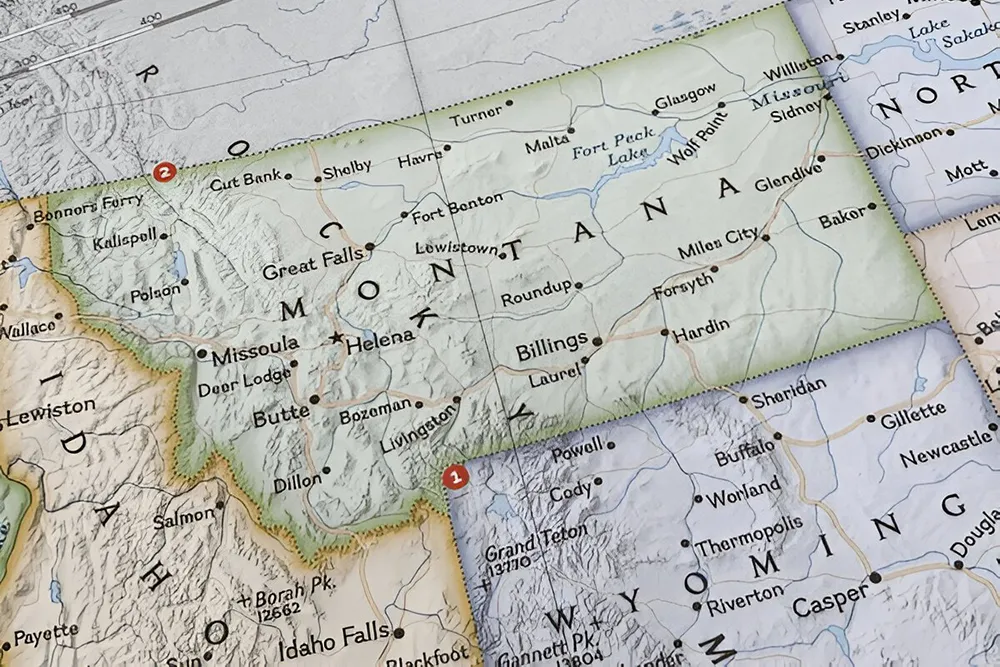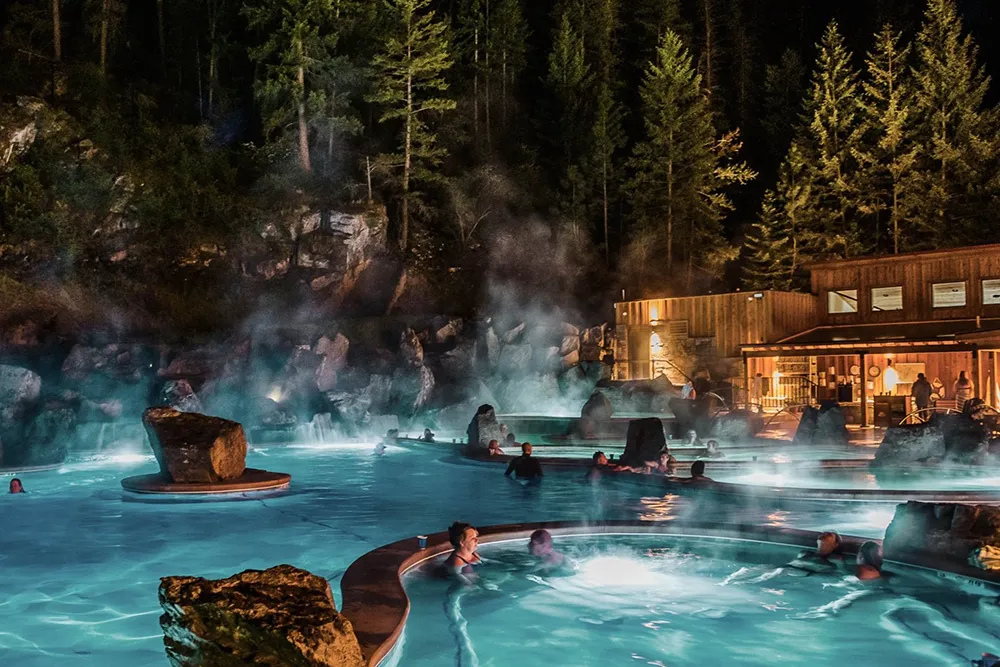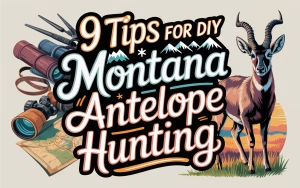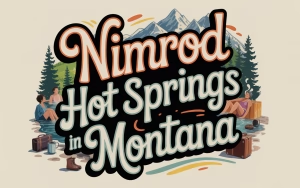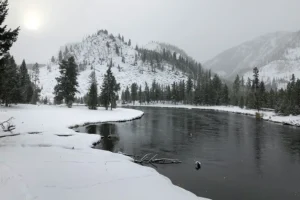Montana, aptly nicknamed “Big Sky Country,” offers visitors an awe-inspiring canvas of diverse landscapes that stretch from the towering Rocky Mountains in the west to the rolling prairies in the east. This fourth-largest state in America boasts some of the most pristine wilderness areas in the continental United States, making it a paradise for nature enthusiasts and adventure seekers alike.
The state’s natural beauty is simply breathtaking – from the glacier-carved valleys and alpine lakes of Glacier National Park to the geothermal wonders of Yellowstone National Park’s northern reaches. Montana’s landscape is punctuated by snow-capped mountain ranges, crystal-clear rivers, vast forests, and expansive grasslands that seem to stretch endlessly beneath the state’s famously wide-open skies.
Beyond its natural splendor, Montana offers a rich tapestry of cultural heritage deeply rooted in Native American history, pioneer settlement, mining booms, and cowboy traditions. This cultural legacy is preserved in numerous museums, historic sites, and living ranches across the state where visitors can experience authentic western hospitality.
For outdoor enthusiasts, Montana presents an unparalleled playground. In winter, world-class skiing and snowboarding opportunities abound at renowned resorts like Big Sky and Whitefish Mountain. Come summer, the state transforms into a haven for hiking, fishing, mountain biking, wildlife viewing, and water sports on Montana’s pristine lakes and rivers.
What truly sets Montana apart as a must-visit destination is its uncrowded nature and genuine authenticity. Unlike many over-touristed destinations, Montana still offers spaces where you can find solitude among spectacular scenery, encounter wildlife in their natural habitat, and connect with locals who maintain a deep appreciation for their land and traditions.
Whether you seek heart-pounding adventure, peaceful communion with nature, or cultural immersion in the American West, Montana delivers experiences that linger in memory long after your visit ends. The state’s natural wonders, combined with its welcoming communities and diverse activities, create a destination that appeals to travelers of all interests and ages.
Table of Contents
Exploring Montana’s National Parks and Natural Landmarks
Montana boasts some of the most breathtaking national parks in the United States, offering visitors unparalleled opportunities to experience pristine wilderness and remarkable natural wonders. The state’s crown jewels—Glacier and Yellowstone National Parks—stand as testament to Montana’s diverse and awe-inspiring landscapes.
Visit Glacier National Park
Known as the “Crown of the Continent,” Glacier National Park encompasses over one million acres of pristine wilderness, complete with towering mountain peaks, crystal-clear alpine lakes, and meadows blanketed with wildflowers. The park’s namesake glaciers, though diminishing due to climate change, still create a spectacular backdrop against the rugged terrain.
The best time to visit Glacier is from mid-June to mid-September when the iconic Going-to-the-Sun Road is fully open. This engineering marvel winds through the heart of the park, offering incomparable views of glacial valleys, cascading waterfalls, and wildlife. For the most serene experience, plan your visit for early morning or evening hours to avoid crowds and increase your chances of spotting wildlife like mountain goats, bighorn sheep, and even grizzly bears.
Don’t miss Logan Pass, the highest point on the Going-to-the-Sun Road, where the Hidden Lake Trail offers breathtaking panoramic views. The Many Glacier area, often referred to as the “Switzerland of North America,” features some of the park’s most dramatic scenery and excellent hiking opportunities.
Explore Yellowstone National Park
While primarily associated with Wyoming, Yellowstone National Park extends into Montana, offering visitors access to the world’s first national park. This geothermal wonderland showcases nature’s raw power through its collection of geysers, hot springs, and bubbling mud pots.
The Montana entrance to Yellowstone, near Gardiner, leads directly to the famous Mammoth Hot Springs, where mineral-rich water has created stunning terraced formations over thousands of years. The Lamar Valley, often called “America’s Serengeti,” provides unparalleled wildlife viewing opportunities, particularly for wolf watchers and those hoping to spot bison herds.
Yellowstone is best visited from late April through October, with summer months offering full access to all park facilities. However, for fewer crowds and the chance to see wildlife more active, consider a visit during May or September when the weather is still pleasant but visitor numbers are lower.
While in Yellowstone, make time for Old Faithful, the park’s most famous geyser, which erupts approximately every 90 minutes. The Grand Prismatic Spring, with its vibrant rainbow of colors created by heat-loving bacteria, offers perhaps the most photographed scene in the park.
Both parks implement timed entry systems during peak season, so advance planning is essential. Whether you’re drawn to Glacier’s alpine splendor or Yellowstone’s geothermal marvels, these national parks showcase Montana’s natural heritage at its most magnificent and should top any Montana itinerary.
Adventure on Montana’s Scenic Drives and Roads
Montana’s vast landscapes are best appreciated from the winding roads that cut through mountains, prairies, and forests. The state boasts some of America’s most spectacular scenic drives, offering travelers the chance to experience breathtaking vistas from the comfort of their vehicles.
Biking the Going-to-the-Sun Road
The Going-to-the-Sun Road in Glacier National Park stands as one of the most engineering marvels in the National Park System. This 50-mile thoroughfare bisects the park, taking travelers from the west entrance near Lake McDonald to St. Mary on the eastern side.
While driving this road is popular, experiencing it by bicycle offers a more intimate connection with the landscape. During spring, before the road fully opens to vehicle traffic, cyclists have exclusive access to portions of this iconic route. The gradual climb provides stunning views of U-shaped valleys, cascading waterfalls, and alpine meadows bursting with wildflowers.
For the best experience, start early in the morning when wildlife is most active and temperatures are cooler. The Logan Pass summit, sitting at 6,646 feet, rewards cyclists with panoramic views that justify every drop of sweat spent reaching the top.
Best Viewpoints Along Going-to-the-Sun Road:
- The Loop: The road’s only switchback offers dramatic views of Heavens Peak
- Oberlin Bend: Look for mountain goats on the cliffs and enjoy views of the Hanging Gardens
- Big Bend: Perhaps the most photographed section, with sweeping views of the valley below
- Jackson Glacier Overlook: One of the few glaciers visible from the roadside
- Wild Goose Island Overlook: The quintessential Glacier National Park photo opportunity at St. Mary Lake
Driving the Beartooth Highway
Often described as “the most beautiful drive in America,” the Beartooth Highway (US Route 212) is a 68-mile stretch connecting Red Lodge, Montana to the northeast entrance of Yellowstone National Park. This high-alpine highway climbs to an astounding 10,947 feet at Beartooth Pass, making it one of the highest roadways in the Northern Rockies.
The drive features nearly 20 mountain peaks reaching over 12,000 feet, pristine mountain lakes, glaciers, and plateaus stretching for miles. The road typically opens from late May through mid-October, weather permitting, as snow can close sections even in summer months.
Best Viewpoints on Beartooth Highway:
- Rock Creek Vista Point: About 13 miles from Red Lodge, offering the first dramatic views of the valley below
- Top of the World Resort: A rustic stop at mile marker 38.7 with incredible mountain vistas
- Beartooth Pass Summit: The highest point with interpretive displays and 360-degree views
- Twin Lakes Overlook: Beautiful alpine lakes surrounded by rugged peaks
- Clay Butte Lookout Tower: A short detour offering panoramic views of the Absaroka Mountains
Safety Tips for Montana’s Scenic Drives
Montana’s mountain roads demand respect and preparation. Follow these tips for a safe journey:
- Check road conditions before departing: Both roads have seasonal closures and can close unexpectedly due to weather.
- Fill your gas tank: Services are limited, especially along Beartooth Highway.
- Pack layers: Weather changes rapidly at high elevations, even in summer.
- Start early: Morning offers better wildlife viewing, less traffic, and reduced afternoon thunderstorm risk.
- Bring binoculars: For spotting distant wildlife without disturbing them.
- Drive slowly: Sharp curves, steep drop-offs, and wildlife require cautious driving.
- Download offline maps: Cell service is spotty or non-existent in many areas.
- Carry water and snacks: Services can be far apart.
- Use pullouts: When taking photos or enjoying views, don’t block traffic.
- Respect wildlife: Keep a safe distance and never feed animals.
These iconic Montana drives aren’t just transportation routes—they’re destinations in themselves, offering some of the most spectacular mountain scenery in North America. Allow plenty of time to savor the journey rather than rushing to your destination.
Water-Based Activities in Montana’s Lakes and Rivers
Montana may be known for its mountains and prairies, but its pristine lakes and rivers offer some of the most memorable experiences in the state. From glacier-fed waters to sprawling lakes, Montana’s aquatic playgrounds provide refreshing adventures during the warm summer months.
Kayak on Lake McDonald
Lake McDonald, the largest lake in Glacier National Park, stretches for 10 miles with crystal-clear waters that reflect the surrounding mountains like a mirror. Kayaking here is a transcendent experience as you glide across waters so clear you can see nearly 30 feet down on calm days. The lake’s eastern shore offers stunning views of the Continental Divide, while the western end provides a perfect launching point for paddlers.
Rentals are available at Apgar Village near the lake’s southern tip, where you can choose from single or tandem kayaks. Early mornings offer the calmest waters and best wildlife viewing opportunities—keep an eye out for eagles soaring overhead and deer coming to drink at the shoreline. The backdrop of multicolored rocks beneath the surface creates a kaleidoscope effect that photographers will treasure.
Enjoy Outdoor Activities on Flathead Lake
Flathead Lake is Montana’s crown jewel of water recreation and the largest natural freshwater lake west of the Mississippi. Covering nearly 200 square miles, this massive body of water offers endless possibilities for aquatic adventures. The lake’s crystal-clear waters reach depths of 370 feet and provide perfect conditions for swimming, sailing, paddleboarding, and water skiing.
The lake features several public access points and beaches, with Wayfarers State Park on the eastern shore offering excellent facilities for day visitors. For a unique experience, boat to Wild Horse Island State Park in the middle of the lake, where wild horses still roam free alongside bighorn sheep and mule deer. Fishing enthusiasts can target lake trout, yellow perch, and whitefish, while cherry orchards along the eastern shore provide sweet treats during summer harvest season.
Cruise the Gates of the Mountains
Named by Meriwether Lewis during the Corps of Discovery expedition, the Gates of the Mountains offers one of Montana’s most dramatic waterways. This limestone canyon on the Missouri River features towering 1,200-foot cliffs that appear to open and close like gates as you navigate the passageway—hence Lewis’s poetic naming of the formation.
The best way to experience this natural wonder is aboard the Gates of the Mountains Tour Boat, which departs from the marina just north of Helena. The 2-hour narrated cruise takes you through the same passageway that Lewis and Clark traversed in 1805, with guides pointing out Native American pictographs, diverse wildlife, and the site of the tragic 1949 Mann Gulch Fire. The boats operate from mid-May through September, with multiple departures daily during peak season.
Other Notable Water Recreation Spots
Beyond these highlights, Montana offers numerous other water-based adventures:
- Blackfoot River: Made famous by Norman Maclean’s “A River Runs Through It,” this river offers premier fly fishing and gentle float trips through scenic canyons.
- Smith River: For the ultimate multi-day floating adventure, the Smith River’s 59-mile stretch between Camp Baker and Eden Bridge provides a wilderness experience so popular that permits are distributed by lottery.
- Bighorn Lake: Straddling the Montana-Wyoming border, this reservoir offers warmer waters ideal for swimming and water sports, with dramatic canyon walls creating a stunning backdrop.
- Whitefish Lake: Just outside the charming town of Whitefish, this lake features a public beach with rental facilities for paddleboards, jet skis, and pontoon boats.
- Lake Koocanusa: This 90-mile-long reservoir created by Libby Dam offers excellent boating and fishing opportunities in Montana’s northwest corner, with numerous secluded coves to explore.
Whether you’re seeking the adrenaline rush of water skiing, the tranquility of a kayak journey, or the perfect fishing spot, Montana’s diverse waterways provide refreshing counterpoints to the state’s mountain adventures.
Wildlife Experiences in Montana
Montana offers some of the most spectacular wildlife viewing opportunities in the United States. The state’s vast wilderness areas are home to a remarkable diversity of animals, including iconic North American species like grizzly bears, wolves, bison, and elk.
Grizzly and Wolf Discovery Center
Located in West Yellowstone, the Grizzly and Wolf Discovery Center provides a unique opportunity to observe these magnificent predators up close in a safe environment. The center is home to grizzly bears and gray wolves that were unable to survive in the wild for various reasons.
Visitors can watch as naturalists provide enrichment activities for the bears, simulating how they would forage for food in the wild. The wolves can be observed in pack behavior, offering insights into their complex social structures. Educational programs run throughout the day, teaching visitors about conservation efforts and the crucial role these apex predators play in maintaining healthy ecosystems.
The center is open year-round, making it a perfect addition to your itinerary regardless of when you visit Montana. It’s particularly valuable for families, offering children the chance to learn about wildlife conservation through interactive exhibits and educational presentations.
National Bison Range
For an unforgettable encounter with America’s largest land mammal, head to the National Bison Range near Moiese. This 18,500-acre wildlife refuge was established in 1908 to protect the American bison from extinction and now supports approximately 350-500 of these magnificent animals.
The scenic drives through the refuge offer excellent opportunities to spot not only bison but also elk, deer, pronghorn antelope, bighorn sheep, and numerous bird species. The Red Sleep Mountain Drive, a 19-mile one-way route, takes visitors through the heart of the refuge with spectacular views of the Mission Mountains.
Spring visitors might witness the birth of bison calves, while fall brings the rutting season when bulls can be seen and heard competing for dominance. The refuge’s visitor center provides informative exhibits about the history and ecology of the bison and the prairie ecosystem.
ZooMontana
For a more structured wildlife viewing experience, especially with young children, ZooMontana in Billings is an excellent choice. This 70-acre wildlife park and botanical garden houses over 100 animals representing species from latitudes similar to Montana’s.
Visitors can observe tigers, wolves, bears, and numerous other species in naturalistic habitats. The zoo places a strong emphasis on education and conservation, with regular keeper talks and interactive programs. The botanical gardens feature native Montana plants and provide a peaceful setting for a leisurely stroll.
ZooMontana is particularly valuable for seeing wildlife that might be difficult to spot in the wild, and it provides important context about animal habitats and conservation challenges facing many species today.
Wildlife Viewing Etiquette and Safety
When viewing wildlife in Montana’s natural areas, safety should always be your priority. Remember these essential guidelines:
- Maintain a safe distance from all wildlife (at least 100 yards from bears and wolves, 25 yards from other large mammals)
- Never feed wild animals
- Use binoculars or telephoto lenses to get a closer look
- Keep food securely stored, especially in bear country
- Make noise while hiking to avoid surprising animals
- Carry bear spray in backcountry areas
- Stay in your vehicle when viewing roadside wildlife
Following these guidelines protects both you and the animals, allowing for sustainable wildlife viewing that doesn’t disrupt natural behaviors.
Best Seasons for Wildlife Spotting
While Montana offers wildlife viewing year-round, certain seasons provide distinct advantages:
Spring (April-June): Excellent for viewing newborn animals and migratory birds. Bears emerge from hibernation, and many animals are more active as they recover from winter.
Summer (June-August): Peak tourist season offers reliable wildlife viewing opportunities, particularly in national parks. Early mornings and evenings are best as animals often seek shade during midday heat.
Fall (September-November): The rutting season for elk and other ungulates provides opportunities to witness impressive mating displays. Bears are actively foraging before hibernation.
Winter (December-March): While challenging, winter offers unique opportunities to spot wolves and other predators against the snow. Bighorn sheep descend to lower elevations, and bison can be dramatically framed against steaming hot springs in Yellowstone.
Whether you choose a guided wildlife tour or venture out independently, Montana’s abundant wildlife viewing opportunities will surely rank among the most memorable experiences of your visit to Big Sky Country.
Hiking Trails and Natural Wonders
Montana’s landscape is a hiker’s paradise, offering trails that wind through pristine wilderness, alongside crystal-clear alpine lakes, and to unique geological formations. From beginner-friendly paths to challenging backcountry routes, the state’s diverse terrain promises unforgettable outdoor experiences for all skill levels.
Hike to Avalanche Lake
Avalanche Lake represents one of Glacier National Park’s most rewarding day hikes. This 4.5-mile round-trip trail begins at the Trail of the Cedars and gradually climbs through a lush forest of ancient western red cedars and hemlocks. The moderate difficulty trail follows Avalanche Creek, where hikers are treated to views of cascading waterfalls carving through a dramatic gorge.
After gaining approximately 500 feet in elevation, the trail opens to reveal Avalanche Lake—a stunning alpine body of water surrounded by towering cliffs. What makes this view particularly spectacular are the multiple waterfalls cascading down the rock faces that feed the lake. The snowmelt creates ribbon-like falls that can number up to seven during peak runoff season in late spring and early summer.
For the best experience, start early in the morning (before 8 AM) to avoid crowds and secure parking at the trailhead. Pack layers, as the temperature near the lake can be significantly cooler than at the trailhead. Wildlife sightings are common, with opportunities to spot deer, mountain goats, and occasionally bears, so carrying bear spray is recommended.
Enjoy Swiftcurrent Lake
Located in the Many Glacier area of Glacier National Park, Swiftcurrent Lake offers both stunning hiking opportunities and peaceful shoreline experiences. The Swiftcurrent Nature Trail is an easy 2.7-mile loop that circles the lake, making it accessible for hikers of all abilities, including families with children.
The trail provides constantly changing perspectives of the surrounding mountains, including Mt. Grinnell and Mt. Wilbur, which are dramatically reflected in the lake’s clear waters on calm mornings. Photographers particularly prize this location for sunrise shots when the peaks glow with alpenglow.
For a more challenging experience, hikers can connect to the Swiftcurrent Pass Trail, which climbs steeply to provide panoramic views of the valley and multiple lakes below. The full pass trail is strenuous (7.6 miles one way with 2,400 feet of elevation gain) and recommended only for experienced hikers.
Wildlife viewing around Swiftcurrent Lake is exceptional, with frequent moose sightings along the marshy areas and occasional grizzly bears on the distant hillsides. The Many Glacier Hotel, situated on the eastern shore, offers a historic stopping point for refreshments or overnight accommodations for those wanting to experience both sunrise and sunset over this magnificent landscape.
Admire the Ringing Rocks
Among Montana’s most unusual natural attractions, the Ringing Rocks near Butte offer a truly unique hiking and geological experience. This isolated boulder field contains rocks that, when struck with a hammer, ring like bells—each with its own distinct tone.
The hike to the Ringing Rocks is relatively short (about a quarter-mile) but takes place on rough terrain. The access road requires a high-clearance vehicle, making the journey part of the adventure. The trail difficulty is rated easy to moderate, though the uneven footing among the rocks requires attention.
What makes these rocks sing remains somewhat mysterious, though geologists believe it relates to their internal composition and the way the rocks are naturally balanced against each other. Interestingly, if a rock is removed from the field, it loses its musical quality, suggesting that the arrangement of the boulders plays a crucial role in their sonic properties.
Visitors are encouraged to bring small hammers (geologist hammers work well) to gently tap the rocks and create their own natural symphony. The best times to visit are during dry conditions, as wet rocks don’t ring as clearly. The surrounding area also offers expansive views of Montana’s landscape, making it worth bringing a camera along with that hammer.
For hikers seeking the extraordinary, this geological wonder provides not just visual but auditory memories of Montana’s diverse natural features. The site has no facilities, so visitors should come prepared with water and sun protection, especially during summer months when the exposed rock field can become intensely hot.
Historical and Cultural Sites in Montana
Montana’s landscape is etched with stories of its rich past, from ancient indigenous civilizations to the Wild West era. The state’s historical and cultural sites offer visitors a chance to step back in time and connect with the diverse heritage that shaped this remarkable region.
Explore Pictograph Cave State Park
Just minutes from Billings, Pictograph Cave State Park houses one of Montana’s most significant archaeological treasures. This National Historic Landmark features a complex of three caves—Pictograph, Middle, and Ghost caves—where prehistoric hunters sought shelter. The cave walls display over 100 pictographs (rock paintings), some dating back more than 2,000 years.
As you walk the quarter-mile interpretive trail, you’ll witness the visual storytelling of multiple indigenous cultures who passed through this area. The park’s visitor center enhances the experience with exhibits explaining the archaeological discoveries and their importance to understanding Montana’s earliest human inhabitants.
Expand Your Knowledge at Little Bighorn Battlefield National Monument
The rolling hills of Little Bighorn Battlefield National Monument mark the site of one of America’s most famous military encounters. Here in June 1876, Lt. Col. George Armstrong Custer and the 7th Cavalry clashed with Lakota, Northern Cheyenne, and Arapaho warriors in what became known as “Custer’s Last Stand.”
Today, this sacred ground honors both the U.S. soldiers and the Native American warriors who fought to preserve their way of life. The monument features:
- The Indian Memorial honoring Native American perspectives
- Custer National Cemetery
- Interpretive walking trails with markers showing where combatants fell
- A visitor center with compelling exhibits and an orientation film
Walking these grounds offers a profound opportunity to contemplate this pivotal moment in American history from multiple perspectives.
Visit Garnet Ghost Town
Nestled in the Garnet Mountain Range, the remarkably preserved Garnet Ghost Town offers a glimpse into Montana’s gold rush era. Once a thriving mining community of nearly 1,000 residents in the 1890s, Garnet was abandoned by the 1940s when the gold played out.
Today, over 30 historic buildings remain, including:
- J.K. Wells Hotel
- Kelly’s Saloon
- Dahl’s Store
- Several miners’ cabins
- The preserved schoolhouse
Unlike many ghost towns that fell victim to vandalism, Garnet’s remote location helped preserve it in remarkable condition. Walking the quiet streets today, you can almost hear the echoes of the bustling mining community that once called this place home.
Appreciate Cowboy Art at C.M. Russell Museum
Located in Great Falls, the C.M. Russell Museum houses the most complete collection of Charles M. Russell’s artwork and personal items in the world. Russell, known as “the cowboy artist,” captured the spirit and drama of the American West through his paintings, sculptures, and illustrated letters.
The museum complex includes Russell’s original home and studio, preserved as they were during his lifetime. With over 2,000 Russell artworks and artifacts, plus collections of other Western artists, the museum offers an unparalleled window into Montana’s cowboy heritage and the vanishing frontier that Russell so lovingly documented.
Montana’s historical sites tell a multifaceted story of struggle, perseverance, and cultural exchange. From ancient indigenous pictographs to boomtown ruins, these landmarks provide context for understanding the complex tapestry of Montana’s heritage and the diverse peoples who have called this land home.
Winter Sports and Mountain Resorts
Montana transforms into a winter wonderland when snow blankets its majestic mountains, creating perfect conditions for world-class skiing, snowboarding, and unique winter sports. The state’s mountain resorts offer some of the best powder and terrain in North America, attracting winter sports enthusiasts from around the globe.
Discover Big Sky Resort
Big Sky Resort lives up to its name with truly expansive terrain spanning 5,850 acres across four connected mountains. With 300+ named runs and a breathtaking 4,350 feet of vertical drop, it’s a paradise for skiers and snowboarders of all skill levels. The resort’s Lone Peak Tram takes adventurous visitors to the summit at 11,166 feet, offering access to some of the most challenging expert terrain in the country and spectacular 360-degree views of three states and two national parks.
Beyond winter, Big Sky transforms into a summer adventure hub with mountain biking trails, zipline tours, and scenic lift rides. The resort’s growing Mountain Village provides excellent dining options, luxury accommodations, and a vibrant après-ski scene, making it a complete mountain destination regardless of season.
Ski at Whitefish Mountain Resort
Nestled in the northern Rockies, Whitefish Mountain Resort combines legendary powder conditions with laid-back Montana charm. The resort features over 3,000 acres of skiable terrain, 111 marked trails, and breathtaking views of Glacier National Park from its summit. What sets Whitefish apart is its unique microclimate that creates the phenomenon known as “snow ghosts” – trees completely encased in crystalline rime ice that create an otherworldly skiing experience through frozen forests.
The resort’s proximity to the charming town of Whitefish makes it ideal for visitors seeking both great skiing and authentic mountain town culture. During summer months, the resort offers an alpine slide, zip tours, and some of Montana’s best mountain biking trails.
Watch a Skijoring Competition at Big Sky
For a truly Montana-specific winter experience, don’t miss the exhilarating sport of skijoring. This unique competition combines skiing with horseback riding, as competitors on skis are pulled behind horses through obstacle courses and jumps at breakneck speeds. Big Sky hosts one of Montana’s premier skijoring competitions each winter, drawing spectators to witness this thrilling marriage of the state’s cowboy heritage and winter sports culture.
The competitions typically feature multiple divisions based on skill level, with cash prizes that attract competitive skijoring teams from across the region. The festive atmosphere includes food vendors, live music, and a genuine celebration of Montana’s distinctive winter culture.
Year-Round Mountain Resort Activities
Montana’s mountain resorts have evolved into four-season destinations. During warmer months, ski runs transform into flowing mountain bike trails, chairlifts carry hikers to panoramic viewpoints, and resort villages buzz with festivals and outdoor concerts.
Big Sky Resort offers scenic lift rides to 11,166 feet for unparalleled mountain views, while Whitefish Mountain Resort features an aerial adventure park with suspended obstacles and ziplines. Both resorts maintain extensive trail systems for hiking and mountain biking, with options ranging from gentle family-friendly paths to technical downhill routes for advanced riders.
The mountain resort areas also serve as gateways to fly fishing, whitewater rafting, and horseback riding adventures, making them ideal base camps for exploring Montana’s diverse outdoor offerings year-round.
Underground Wonders: Montana’s Cave Systems
Montana’s subterranean landscape offers just as much wonder as its towering mountains and sprawling plains. The state’s cave systems provide a fascinating glimpse into geological processes that have been ongoing for millions of years, creating spectacular formations hidden beneath the surface.
Tour the Lewis & Clark Caverns State Park
The crown jewel of Montana’s underground attractions is undoubtedly Lewis & Clark Caverns State Park. Despite its name, the famous explorers never actually visited these caves—they were discovered long after their expedition. Located near Three Forks, these limestone caverns represent one of the largest known cave systems in the Northwest.
The caverns formed over millions of years as slightly acidic groundwater slowly dissolved the limestone, creating an intricate network of passages and rooms adorned with stunning formations. Visitors can marvel at stalactites hanging like icicles from the ceiling, stalagmites reaching upward from the floor, and columns where these formations have joined together over millennia.
The park offers guided tours that last approximately two hours and cover about two miles. These tours are available from May through September, with limited candlelight tours in December. The standard tour involves some bending, stooping, and navigating 600 stairs, but the breathtaking beauty inside makes every step worthwhile.
Your knowledgeable guide will explain the cave’s formation, point out notable features like the “Paradise Room” with its chocolate-colored flowstone, and share the fascinating history of the cave’s discovery and development. The constant 50°F (10°C) temperature inside provides a refreshing escape from summer heat or a relatively warm adventure during cooler months.
Cave Formation and Geological Significance
The caves throughout Montana represent different geological processes. While Lewis & Clark Caverns formed through limestone dissolution, other caves in the state developed through volcanic activity, erosion, or even ice formation.
Inside these caves, you’ll witness nature’s artistry in slow motion. The colorful mineral deposits—ranging from whites and tans to reds and browns—tell the story of water carrying dissolved minerals through rock over countless centuries. Each drip builds these formations at the painstakingly slow rate of roughly one cubic inch per century.
This geological timeline offers perspective on Earth’s age and the patient processes that shape our planet. The caves essentially serve as time capsules, preserving evidence of ancient environments and climate conditions that scientists continue to study today.
Guided Tour Options and Accessibility
Montana’s caves offer various tour experiences to accommodate different interests and physical abilities:
- Standard Tours: The most common option at Lewis & Clark Caverns, these guided walks take you through the main passages and chambers.
- Wild Cave Tours: For the more adventurous, some caves offer off-trail experiences that involve crawling, climbing, and exploring undeveloped sections.
- Educational Tours: Focused on geology, biology, or history, these specialized tours dive deeper into specific aspects of cave science.
- Accessible Options: Some portions of certain caves offer wheelchair-accessible routes or virtual tours for those unable to navigate the physical challenges.
Most cave tours require reservations, especially during peak summer months. Prices typically range from $5-15 per person, with discounts for children, seniors, and groups.
Safety and Conservation Considerations
Caves are delicate ecosystems that require special care and consideration from visitors. When exploring Montana’s underground wonders, keep these important points in mind:
Safety First: Always stay with your guide and follow all safety instructions. Cave environments can be challenging with low ceilings, uneven floors, and limited lighting. Wear appropriate footwear with good traction, and consider bringing a light jacket even in summer due to the cool temperatures.
White-Nose Syndrome Prevention: This deadly fungal disease affecting bats has devastated populations across North America. To prevent spreading it, never wear clothing or bring equipment that has been in other caves without proper decontamination.
Leave No Trace: The conservation mantra is especially important underground. Never touch cave formations—the oils from human hands can permanently discolor or stop the growth of formations that took thousands of years to create. Take nothing but pictures and leave nothing but footprints.
Photography Challenges: While photography is generally permitted, flash photography may be restricted in areas with sensitive wildlife. The challenging lighting conditions make cave photography difficult, so consider bringing a camera with manual settings if capturing images is important to you.
By respecting these underground environments, we ensure that future generations can continue to experience the wonder of Montana’s remarkable cave systems. The Lewis & Clark Caverns and other caves throughout the state offer not just a tourist attraction, but a journey through time and an opportunity to appreciate the hidden natural processes constantly at work beneath our feet.
Urban Exploration in Montana’s Charming Towns
Montana isn’t just about wilderness adventures—its charming towns offer vibrant cultural scenes, unique shopping experiences, and delicious local cuisine. From historic main streets to contemporary art galleries, Montana’s urban areas provide a perfect complement to the state’s natural wonders.
Stroll Through Downtown Bozeman
Bozeman stands out as one of Montana’s most vibrant small cities, with a downtown area that perfectly balances historic charm with modern amenities. Main Street is lined with beautifully preserved 19th-century buildings housing everything from boutique shops to farm-to-table restaurants.
Begin your exploration at the historic Baxter Hotel, an iconic landmark in downtown Bozeman since 1929. From there, wander along Main Street where you’ll find independent bookstores like Country Bookshelf, Montana’s largest independent bookstore offering an impressive selection of local literature and western history.
Fashion enthusiasts will appreciate shops like Heyday and Meridian, which offer carefully curated collections of clothing and accessories. For unique Montana-made gifts, visit Altitude Gallery or The Architect’s Wife, featuring works by local artisans and designers.
Bozeman’s food scene is equally impressive. Blackbird Kitchen serves wood-fired Italian cuisine using locally-sourced ingredients, while Montana Ale Works offers an extensive beer selection alongside hearty Montana fare in a renovated railway freight house. For coffee lovers, Wild Joe’s Coffee Spot provides the perfect atmosphere to relax and people-watch.
The arts thrive in Bozeman as well. The Emerson Center for the Arts & Culture houses galleries, studios, and hosts regular events, while the Rialto theater offers an intimate venue for live music and film screenings. During summer months, don’t miss “Music on Main,” when downtown streets close for outdoor concerts every Thursday evening.
Other Noteworthy Montana Towns Worth Visiting
Missoula offers a vibrant arts scene centered around Higgins Avenue. The historic Wilma Theater hosts concerts and films, while the First Friday Gallery Night sees downtown businesses transform into art spaces each month. Don’t miss the Hip Strip, a collection of eclectic shops and restaurants south of the Clark Fork River.
Helena, Montana’s capital, features a walkable downtown with the stunning Montana State Capitol building and Last Chance Gulch, a pedestrian mall built over the original gold mining gulch that founded the city. The Holter Museum of Art and the Great Northern Carousel provide cultural and family-friendly attractions.
Whitefish combines mountain town charm with sophisticated amenities. Central Avenue features galleries, outfitters, and restaurants like Loula’s Cafe, famous for its huckleberry pie. During winter, the town transforms into a festive wonderland with snow sculptures and holiday lights.
Livingston offers a perfect blend of Western heritage and artistic flair. This former railroad town has been discovered by artists and writers, resulting in numerous galleries and bookstores. The historic Murray Hotel, once frequented by film stars and literary figures, remains a centerpiece of downtown.
Red Lodge provides a quintessential mountain town experience with its historic Broadway Avenue. After a day exploring nearby Beartooth Highway, visitors can enjoy local breweries, western outfitters, and candy shops housed in charming brick buildings from the early 1900s.
These charming Montana towns each offer their own unique character and attractions, providing welcome urban respites between your wilderness adventures throughout the state.
Montana Ranch Experiences and Western Culture
Montana’s identity is deeply intertwined with its ranching heritage and cowboy culture. For visitors seeking an authentic western experience, the state offers numerous opportunities to immerse yourself in this iconic lifestyle.
Cattle Drive at a Montana Ranch
Few experiences capture the essence of Montana’s western heritage like participating in a genuine cattle drive. Several working ranches throughout the state welcome guests to join their cowboys in moving herds across the vast Montana landscape. During these authentic experiences, you’ll learn to ride like a true wrangler, help guide cattle through mountain meadows and river crossings, and end your days around a campfire under the stars.
The experience typically lasts between 3-7 days, with guests staying in rustic but comfortable accommodations. Ranches like Lonesome Spur Ranch near Bridger and Burnt Leather Ranch in Big Timber offer these immersive experiences where city slickers can transform into genuine cowboys and cowgirls.
Check Out The Resort at Paws Up
For those seeking western adventure without sacrificing luxury, The Resort at Paws Up near Greenough offers the perfect blend of authentic ranch activities and world-class amenities. This 37,000-acre working cattle ranch doubles as a luxury resort, featuring elegant safari-style tent accommodations and private luxury homes.
At Paws Up, guests can participate in cattle drives, horseback riding, and chuck wagon dinners, then retreat to accommodations featuring fine linens, heated bathroom floors, and personal spa services. The resort’s “glamping” experience has made it a favorite among celebrities and travelers seeking both adventure and indulgence.
Activities include fly fishing on the Blackfoot River (made famous in “A River Runs Through It”), ATV tours, and clay shooting. Their equestrian program is particularly noteworthy, offering everything from basic riding lessons to advanced horsemanship clinics.
Choosing the Right Ranch Experience
Montana’s ranch experiences range from working ranches where guests participate in daily chores to resort ranches focused primarily on recreation. When selecting your ideal ranch vacation, consider these factors:
- Authenticity level: Do you want to experience genuine ranch work or prefer a more curated experience?
- Comfort requirements: Options range from rustic bunkhouses to luxury cabins with private hot tubs.
- Family-friendliness: Many ranches offer specialized programs for children, while others cater primarily to adults.
- Activities offered: Beyond horseback riding, ranches may specialize in fly fishing, wildlife viewing, or culinary experiences.
- Season: Summer offers warm-weather activities, while winter ranches provide sleigh rides and snow sports.
Popular options include Triple Creek Ranch near Darby (adults-only luxury), The Ranch at Rock Creek near Philipsburg (all-inclusive luxury), and McGinnis Meadows Cattle & Guest Ranch near Libby (working cattle ranch with horsemanship focus).
Regardless of which ranch you choose, these experiences provide a genuine connection to Montana’s western heritage that can’t be replicated elsewhere. The combination of breathtaking landscapes, authentic cowboy culture, and Montana’s legendary hospitality creates memories that will last long after you’ve hung up your spurs.
Museums and Educational Experiences
Montana’s museums offer visitors a fascinating journey through the state’s rich history, from prehistoric times to its mining and cowboy heritage. These educational attractions provide immersive experiences that bring the past to life while entertaining visitors of all ages.
At the World Museum of Mining in Butte, you’ll step back in time to experience Montana’s mining heyday. Set on the grounds of the former Orphan Girl Mine, this living history museum features over 50 exhibit buildings in its recreated mining town called “Hell Roarin’ Gulch.” Visitors can descend 100 feet underground into an actual mine shaft, gaining a profound appreciation for the challenging conditions miners faced. The museum’s extensive collection includes thousands of artifacts, from mining equipment and tools to personal items that tell the stories of the diverse immigrant communities who sought their fortunes in Montana’s mines.
The Museum of the Rockies in Bozeman houses one of the world’s most significant collections of dinosaur fossils, making it a must-visit for paleontology enthusiasts. The museum’s crown jewel is its Siebel Dinosaur Complex, featuring Montana’s own T. rex specimens and the largest T. rex skull ever discovered. The museum’s connection to renowned paleontologist Jack Horner (who inspired the character in Jurassic Park) adds to its prestige. Children will be mesmerized by the full-scale dinosaur models and interactive exhibits that explain how these massive creatures lived and died in what is now Montana. Beyond dinosaurs, the museum offers changing exhibits on regional history, a state-of-the-art planetarium, and the living history farm that demonstrates pioneer life in the late 1800s.
Art lovers shouldn’t miss the C.M. Russell Museum in Great Falls, which celebrates America’s cowboy artist Charles M. Russell. This comprehensive collection includes over 4,000 artworks, artifacts, and personal items that showcase Russell’s extraordinary talent for capturing the spirit of the American West. The museum complex includes Russell’s original home and studio, preserved as they were during his lifetime. Visitors can see his actual workspace, complete with paints, brushes, and unfinished works. The museum’s exhibits go beyond Russell’s art to include contemporary Western artists and Native American artifacts, providing context for understanding Montana’s cultural heritage.
For families traveling with children, these museums offer specially designed interactive experiences. Many feature hands-on discovery centers where kids can touch fossils, pan for gold, or create their own Western-inspired artwork. Educational programs, including guided tours tailored for different age groups, help make complex historical concepts accessible and engaging for young minds.
Whether you’re a history buff, art enthusiast, or traveling with curious children, Montana’s museums provide educational experiences that entertain while deepening your appreciation for the state’s unique place in American history.
Unique and Unexpected Montana Attractions
Montana may be known for its stunning national parks and outdoor adventures, but the state also harbors some truly unusual and unexpected attractions that showcase its diverse cultural landscape and geological oddities. These hidden gems offer visitors a chance to experience something completely different from the typical Montana itinerary.
Find Your Peace at the Garden of One Thousand Buddhas
Nestled in the Jocko Valley near Arlee, the Garden of One Thousand Buddhas presents an unexpected spiritual sanctuary in the heart of Montana. This peaceful 10-acre site features a striking arrangement of Buddha statues positioned in the shape of an eight-spoked dharma wheel. The garden serves as a public park and Buddhist center, welcoming visitors of all faiths to experience its tranquil atmosphere.
Walking through the meticulously maintained grounds, you’ll encounter white-washed stupas, colorful prayer flags fluttering in the breeze, and the centerpiece—a 24-foot statue of Yum Chenmo, the Great Mother of Wisdom. The contrast between the Buddhist iconography and the surrounding Montana landscape creates a uniquely beautiful and contemplative experience.
The garden hosts various events throughout the year, including the annual Peace Festival in September. Whether you’re seeking spiritual reflection or simply appreciating the artistic beauty of the installation, this hidden gem offers a serene respite from your adventures.
Admire the Ringing Rocks
Just outside of Butte lies one of Montana’s most peculiar natural phenomena—the Ringing Rocks. This unusual boulder field contains rocks that, when struck with a hammer, ring like bells, each producing a different tone. What makes this site truly special is that these same rocks, when removed from the field, lose their musical quality.
Scientists believe the unique resonance comes from the particular way the rocks formed and weathered over millions of years, creating an internal structure that allows them to vibrate like bells. Visitors are encouraged to bring a hammer (though not to remove any rocks) and create their own geological symphony.
The site requires a bit of off-road driving to reach, but the unusual experience of playing “music” on ancient rocks makes it well worth the journey. Just be prepared for dusty conditions and bring plenty of water, as this site sits in an exposed area with little shade.
Marvel at the Berkeley Pit
While not conventionally beautiful, the Berkeley Pit in Butte represents one of America’s most fascinating examples of environmental reclamation challenges. This former open-pit copper mine is now filled with highly acidic water containing dissolved heavy metals and toxic substances.
Despite its contaminated nature, the pit has become an unusual tourist attraction with an observation platform where visitors can view this stark reminder of Montana’s mining history. The surreal, otherworldly appearance of the rusty-colored water against the terraced mine walls creates a strangely compelling landscape.
Scientists study the pit’s unique ecosystem, as some extremophile organisms have adapted to survive in its toxic waters. The site serves as both a cautionary environmental tale and a testament to the scale of human engineering.
Explore Garnet Ghost Town
Hidden in the mountains east of Missoula, Garnet Ghost Town offers a perfectly preserved glimpse into Montana’s gold rush era. Unlike many commercialized ghost towns, Garnet remains authentically untouched, with over 30 historic buildings still standing in their original locations.
Wander through the abandoned saloon, hotel, and cabins, imagining the once-bustling mining community that thrived here in the 1890s. The remote location and limited winter access have helped preserve Garnet’s authentic character, making it one of the best-preserved ghost towns in the country.
The site is particularly atmospheric in winter when accessible only by snowmobile or cross-country skis, though summer offers easier access and regular guided tours. History enthusiasts will appreciate the genuine artifacts still found throughout the buildings and the palpable sense of stepping back in time.
Experience the Sip ‘n Dip Lounge’s Mermaid Show
For a truly unexpected Montana experience, visit the Sip ‘n Dip Lounge in Great Falls. This tiki-themed bar features a large window behind the counter that looks into a swimming pool where performers dressed as mermaids entertain patrons several nights a week.
This quirky attraction has gained national attention as one of America’s most unique bars. The vintage 1960s decor, complete with blue lighting and tropical ambiance, creates a surreal oasis in this landlocked state. Piano Pat, a legendary local entertainer who performed at the lounge for over 50 years, helped establish its reputation as a must-visit Montana institution.
The combination of kitsch decor, mermaid performers, and strong tropical drinks makes for an unforgettable Montana evening that couldn’t be further from the expected cowboy bar experience.
These unusual attractions reveal Montana’s surprising diversity beyond its famous natural landscapes. Taking time to explore these offbeat destinations adds depth and unexpected delight to any Montana vacation itinerary.
Outdoor Adventure Sports and Activities
Montana’s rugged landscape creates the perfect playground for thrill-seekers and outdoor enthusiasts. From vertical rock faces to frozen waterfalls and winding mountain trails, the state offers world-class adventure sports opportunities for all skill levels.
Rock and Ice Climbing With Montana Alpine Guides
Montana Alpine Guides stands as the premier guiding service for those looking to scale the state’s impressive rock formations or tackle winter ice climbing challenges. Their certified guides offer experiences ranging from beginner lessons to advanced technical climbs in locations like Hyalite Canyon and Gallatin Canyon.
Hyalite Canyon transforms during winter months into one of North America’s premier ice climbing destinations, with over 250 ice routes ranging from beginner-friendly pitches to challenging multi-pitch climbs. The frozen waterfalls create surreal blue ice formations that attract climbers from around the world.
For rock climbing enthusiasts, the limestone cliffs of Natural Bridge near Big Timber and the granite walls of Gallatin Canyon provide excellent summer climbing opportunities. Montana Alpine Guides offers customized experiences based on your skill level, with all necessary equipment provided and safety as their top priority.
Mountain Biking Meccas
Montana’s diverse terrain creates exceptional mountain biking opportunities across the state. The Whitefish Trail network offers over 42 miles of flowing single-track suitable for various skill levels, while the more technical trails at Copper City near Three Forks challenge experienced riders with berms, jumps, and rocky descents.
In Missoula, the extensive trail system at Mount Jumbo and Mount Sentinel provides spectacular views alongside technical riding challenges. Meanwhile, Helena has earned recognition as a Silver-Level Ride Center by the International Mountain Bicycling Association, with over 80 miles of trails accessible from downtown.
For those seeking a truly epic experience, the 76-mile Bangtail Divide Trail near Bozeman offers a high-alpine backcountry adventure with breathtaking views and challenging terrain. Local bike shops in most mountain towns offer rentals, maps, and insider tips for the best current trail conditions.
Safety Considerations for Adventure Sports
Montana’s wilderness presents real hazards that require proper preparation. Weather conditions can change rapidly, particularly at higher elevations, so layered clothing and emergency supplies are essential even for day trips. Adventure sports participants should always:
- Research routes and conditions thoroughly before setting out
- Inform someone of your itinerary and expected return time
- Carry appropriate safety equipment for your activity
- Consider hiring local guides for unfamiliar terrain
- Check weather forecasts and be prepared to adjust plans
- Carry bear spray in bear country and know how to use it
Montana Alpine Guides and other reputable outfitters prioritize comprehensive safety briefings and provide appropriate equipment for their guided adventures. For independent adventurers, connecting with local outdoor shops can provide valuable current information about conditions and hazards.
Whether you’re scaling frozen waterfalls in Hyalite Canyon, mountain biking the flowing trails near Whitefish, or discovering your own adventure, Montana’s outdoor playgrounds offer some of North America’s most rewarding and spectacular adventure sports experiences.
Montana’s Hot Springs and Spa Retreats
Montana’s geothermal wonders offer more than just stunning landscapes; they provide visitors with luxurious and rejuvenating experiences. The state’s hot springs and spa retreats are among the best things to do in Montana, offering a perfect blend of relaxation and natural beauty. Here are some of the most popular hot springs destinations that should be on your list of best places to visit in Montana:
Chico Hot Springs
Nestled in the heart of Paradise Valley, Chico Hot Springs is a historic resort that has been welcoming visitors since 1900. The resort features two open-air mineral pools fed by natural hot springs, offering breathtaking views of the surrounding Absaroka Mountains. Visitors can soak in the healing waters, indulge in world-class dining at the resort’s restaurant, or pamper themselves with spa treatments. The resort also offers horseback riding, hiking, and fly fishing, making it a perfect base for exploring the nearby Yellowstone National Park.
Fairmont Hot Springs
Located between Butte and Anaconda, Fairmont Hot Springs Resort is a year-round destination that offers something for everyone. The resort boasts two Olympic-sized pools, two soaking pools, and a 350-foot water slide. The mineral-rich waters, naturally heated to temperatures between 90°F and 104°F, are known for their therapeutic properties. Visitors can enjoy golf, tennis, and hiking in the summer, or hit the nearby ski slopes in the winter. With its variety of accommodations and on-site dining options, Fairmont Hot Springs is an ideal spot for families and couples alike.
Quinn’s Hot Springs Resort
Tucked away in the lush forests of western Montana, Quinn’s Hot Springs Resort offers a secluded retreat along the Clark Fork River. The resort features six pools of varying temperatures, from cool plunge pools to hot soaking tubs, all fed by natural mineral springs. Guests can stay in cozy cabins or lodge rooms, dine at the on-site restaurant, and enjoy activities like hiking, fishing, and wildlife viewing. The adults-only pool area provides a tranquil escape for those seeking a more serene experience.
These hot springs resorts not only offer some of the best things to do in Montana but also provide unique ways to experience the state’s natural beauty. Whether you’re looking to soothe sore muscles after a day of hiking, escape the winter chill, or simply unwind in a picturesque setting, Montana’s hot springs and spa retreats offer unforgettable experiences that showcase the best of Big Sky Country.
Seasonal Highlights: When to Visit Montana
Montana transforms dramatically with each season, offering unique experiences throughout the year. Timing your visit can make all the difference in experiencing the Big Sky state at its finest.
Summer (June-August): Peak Season Beauty
Summer brings Montana to life with vibrant landscapes and comfortable temperatures ranging from 70-85°F. This is prime time for:
- Glacier National Park exploration when all roads (including Going-to-the-Sun) are fully open
- Water activities on Flathead Lake and other waterways
- Hiking with access to high-elevation trails free of snow
- Wildlife viewing opportunities at their peak
- Farmers markets in towns like Missoula, Bozeman, and Whitefish
Summer also hosts signature events like the Montana Folk Festival in Butte (July), North American Indian Days in Browning (July), and the Montana State Fair in Great Falls (late July/early August).
Fall (September-November): Colors and Solitude
Fall delivers spectacular foliage, cooler temperatures, and significantly fewer crowds:
- Wildlife viewing improves as animals prepare for winter
- Photography opportunities with golden aspens against mountain backdrops
- Hiking remains excellent with cooler temperatures
- Fishing peaks as water temperatures drop
Don’t miss the Harvest Festivals throughout September and October or the Tamarack Festival in Seeley Lake celebrating the changing larch trees.
Winter (December-March): Snow Adventures
Winter transforms Montana into a snow-covered playground with temperatures often below freezing:
- Skiing and snowboarding at resorts like Whitefish Mountain and Big Sky
- Snowmobiling on hundreds of miles of groomed trails
- Dog sledding adventures near Yellowstone
- Ice fishing on frozen lakes
- Hot springs soaking is especially magical surrounded by snow
Winter events include the Whitefish Winter Carnival (February), unique skijoring competitions in Whitefish and Big Sky, and the Bozeman Ice Festival (December).
Spring (April-May): Renewal and Wildlife
Spring brings renewal, wildflowers, and baby wildlife, though weather can be unpredictable:
- Wildlife viewing as young animals emerge
- Wildflower blooms creating carpets of color
- Whitewater rafting during peak runoff
- Bird watching during migration periods
- Hiking at lower elevations while mountains remain snow-covered
Spring hosts the Montana Folk Festival in Butte and various Native American powwows throughout the state.
Avoiding Crowds: Strategic Timing
To experience Montana’s highlights with fewer people:
- Visit Glacier National Park in late September or early October for fall colors without summer crowds
- Explore Yellowstone’s Montana sections midweek during shoulder seasons (May or September)
- Book accommodations months in advance for summer visits
- Consider early morning adventures at popular sites (before 9am)
- Visit popular attractions during dinner hours when crowds thin out
- Explore lesser-known areas like the Missouri River Breaks or the Pryor Mountains
Montana’s seasonal diversity means there’s never truly a bad time to visit—just different experiences waiting to be discovered throughout the year.
Practical Tips for Planning Your Montana Adventure
Montana’s vast wilderness and seasonal extremes require thoughtful preparation to ensure your vacation is memorable for all the right reasons. From securing the right accommodations to knowing what permits you’ll need, here’s how to plan your Montana adventure effectively.
Accommodation Options
Montana offers diverse lodging experiences that can enhance your vacation:
- Mountain Lodges and Resorts: Perfect for those exploring Glacier National Park or skiing destinations, these often feature rustic luxury with amenities like hot tubs and fireplaces.
- Dude Ranches: Experience authentic western hospitality with all-inclusive packages that typically include meals, horseback riding, and evening entertainment.
- Vacation Rentals: Ideal for families or longer stays, cabins and homes throughout Montana provide privacy and space, especially around popular destinations like Whitefish and Big Sky.
- Glamping: For those who want to immerse in nature without sacrificing comfort, glamping sites near Yellowstone and Glacier offer canvas tents with real beds and amenities.
- Historic Hotels: Cities like Helena and Butte feature beautifully preserved historic hotels that connect you to Montana’s past.
Book accommodations 6-12 months in advance for summer visits, especially near national parks.
Transportation Considerations
Getting around Montana requires planning due to its vast size:
- Rental Cars: Essential for most visitors. Four-wheel drive vehicles are recommended, especially if visiting during winter or exploring remote areas.
- Airport Options: Major airports include Bozeman, Missoula, Billings, and Kalispell (near Glacier). Choose based on your itinerary to minimize driving time.
- Driving Distances: Be realistic about travel times – driving between attractions often takes longer than expected due to mountain roads and wildlife crossings.
- Public Transportation: Limited outside urban areas, though some shuttle services operate to popular destinations like ski resorts.
- Scenic Trains: Consider Amtrak’s Empire Builder route, which runs along Montana’s northern border with stops near Glacier National Park.
Packing Essentials by Season
Montana’s weather can be unpredictable, so packing appropriately is crucial:
Summer (June-August)
- Lightweight, breathable clothing
- Rain jacket and layers for cool evenings
- Sun protection (hat, sunscreen, sunglasses)
- Hiking boots and comfortable walking shoes
- Insect repellent
- Daypack for hiking
- Swimwear for lake activities
Fall (September-November)
- Warm layers including fleece and light down jackets
- Waterproof outer layer
- Gloves and beanie for mornings and evenings
- Sturdy footwear for potentially muddy trails
- Binoculars for wildlife viewing
Winter (December-March)
- Heavy insulated jacket
- Thermal base layers
- Waterproof snow pants
- Insulated waterproof boots
- Heavy gloves, wool socks, and warm hat
- Hand and foot warmers
- Sunglasses (snow glare can be intense)
Spring (April-May)
- Waterproof boots for muddy conditions
- Rain gear
- Layers for fluctuating temperatures
- Light gloves and hat
Permits and Reservations
Many of Montana’s popular activities require advance planning:
- National Park Entry: Glacier National Park requires vehicle reservation tickets for the Going-to-the-Sun Road during peak season (typically May-September).
- Backcountry Permits: Required for overnight wilderness camping in national parks and many wilderness areas. These can be reserved in advance.
- Fishing Licenses: Required for anyone 12 and older. Options include 2-day, 10-day, or season-long permits available online through Montana Fish, Wildlife & Parks.
- Hunting Permits: If planning a hunting trip, apply for permits months in advance through the lottery system.
- Campground Reservations: Popular campgrounds in national parks can be reserved up to 6 months in advance and fill quickly for summer dates.
- River Floating Permits: Some popular rivers require permits during peak season, especially in protected areas.
Wildlife Safety Awareness
Montana’s abundant wildlife requires respect and caution:
- Carry bear spray when hiking and know how to use it
- Store food properly when camping
- Maintain safe distances from all wildlife
- Learn proper protocols for bear encounters before hiking
Planning ahead ensures your Montana adventure will be filled with amazing experiences rather than logistical challenges. The state’s natural wonders reward those who come prepared for its unique environments and seasonal conditions.
FAQs About Montana: The Treasure State
What are the best places to visit in Montana?
Montana offers incredible destinations including Yellowstone National Park, Glacier National Park, historic ghost towns like Bannack and Virginia City, vibrant cities like Missoula and Bozeman, and natural wonders like Lewis and Clark Caverns and Flathead Lake.
What is the best time of year to visit Montana?
The best time to visit Montana depends on your preferred activities. Summer (June to August) is ideal for hiking, kayaking, and exploring national parks, with warm temperatures and long daylight hours. Fall (September to October) offers beautiful foliage and fewer crowds. Winter (December to March) is perfect for skiing and winter sports at resorts like Big Sky and Whitefish Mountain. Spring (April to May) can be unpredictable weather-wise but offers opportunities for wildlife viewing and lower prices.
What wildlife can I see in Montana?
Montana is home to diverse wildlife including grizzly bears, wolves, bison, elk, moose, bighorn sheep, mountain goats, and numerous bird species. The best viewing opportunities are in Yellowstone National Park, Glacier National Park, and the National Bison Range.
What are the top outdoor activities in Montana?
Montana offers world-class outdoor recreation including hiking, fishing, skiing, mountain biking, whitewater rafting, horseback riding, camping, and hot springs soaking. The state’s diverse landscapes provide endless adventures for all skill levels.
Are Montana’s hot springs worth visiting?
Absolutely! Montana’s natural hot springs like Chico Hot Springs, Fairmont Hot Springs, and Quinn’s Hot Springs Resort offer relaxing and therapeutic experiences with beautiful mountain backdrops, making them perfect for unwinding after outdoor adventures.
How can I experience Native American culture in Montana?
Visit one of Montana’s seven Indian reservations, attend powwows like Crow Fair or North American Indian Days, explore museums like the Museum of the Plains Indian, and respect tribal customs when visiting Native lands.
What are the must-see scenic drives in Montana?
Don’t miss the breathtaking Beartooth Highway, the historic Lewis and Clark Trail, and the picturesque Pintler Scenic Route. These drives showcase Montana’s diverse landscapes from mountain passes to rolling prairies.
Is it possible to visit both Yellowstone and Glacier National Parks in one trip?
Yes, though they’re about 400 miles apart. Allow at least a week to experience both parks properly, with 2-3 days in each park and travel time between them. Many visitors combine both parks in a single Montana adventure.
What should I pack for a Montana vacation?
Pack layers regardless of season, as temperatures can fluctuate dramatically. Include sturdy hiking boots, sun protection, rain gear, and bear spray if hiking. In winter, bring warm clothing, and in summer, don’t forget swimwear for hot springs and lakes.
How accessible are Montana’s ghost towns and historical sites?
Many ghost towns like Bannack and Virginia City are easily accessible by car during summer months. Some remote sites may require 4WD vehicles or have seasonal closures. Check visitor information before planning your historical exploration of the Treasure State.
How many days should I plan for a trip to Montana?
To experience the highlights of Montana, plan for at least 7-10 days. This allows time to explore both Glacier and Yellowstone National Parks, enjoy outdoor activities like hiking and kayaking, and visit some of the state’s cultural attractions. If you want to include a ranch stay or more in-depth exploration of specific regions, consider extending your trip to 14 days or more.
Do I need a car to explore Montana?
Yes, having a car is highly recommended for exploring Montana. The state is large and many attractions are spread out. Public transportation options are limited, especially in rural areas and national parks. Renting a car will give you the flexibility to visit multiple destinations and enjoy scenic drives like the Going-to-the-Sun Road or Beartooth Highway.
Conclusion: Creating Your Perfect Montana Itinerary
Montana’s vast landscapes and diverse attractions can seem overwhelming to organize into a cohesive vacation plan. The key to a memorable Montana experience lies in thoughtful planning that balances iconic destinations with hidden gems while allowing time to soak in the state’s unique atmosphere.
Sample Itineraries for Different Trip Lengths
3-Day Weekend Getaway:
- Day 1: Explore Bozeman’s downtown in the morning, then spend the afternoon at the Museum of the Rockies
- Day 2: Full day at a portion of Yellowstone National Park, focusing on Old Faithful and nearby geothermal features
- Day 3: Morning wildlife viewing, followed by a relaxing afternoon at a local lake or hot spring
One-Week Adventure:
- Days 1-2: Glacier National Park highlights, including Going-to-the-Sun Road and a hike to Avalanche Lake
- Day 3: Explore Whitefish and enjoy Whitefish Lake
- Day 4: Travel day with stops at Flathead Lake and the Garden of One Thousand Buddhas
- Day 5: Visit the National Bison Range and continue to Missoula
- Days 6-7: Explore the Bozeman area, including downtown and nearby outdoor activities
Two-Week Montana Immersion:
- Days 1-4: Thorough exploration of Glacier National Park with multiple hikes and activities
- Day 5: Whitefish and Flathead Lake
- Days 6-7: Missoula area, including the National Bison Range and day trips
- Day 8: Travel along Beartooth Highway to Red Lodge
- Days 9-11: Yellowstone National Park highlights
- Day 12: Big Sky Resort area activities
- Day 13: Bozeman and Museum of the Rockies
- Day 14: Lewis & Clark Caverns and historic sites
Combining Multiple Attractions Efficiently
Montana’s attractions are spread across a vast area, so planning routes that minimize backtracking is essential. Consider these regional clusters:
- Northwest Montana: Combine Glacier National Park with Whitefish, Flathead Lake, and the Garden of One Thousand Buddhas.
- Southwest Montana: Group Yellowstone National Park with Big Sky Resort, Bozeman, and Lewis & Clark Caverns.
- Central Montana: Explore the C.M. Russell Museum, Gates of the Mountains, and ranch experiences.
- Eastern Montana: Visit the Little Bighorn Battlefield Monument along with regional historical sites.
The most efficient Montana itineraries follow a logical geographical progression. Allow for flexibility—Montana’s weather can be unpredictable, and spontaneous wildlife sightings or local recommendations might inspire detours.
Final Thoughts on What Makes Montana Special
What truly sets Montana apart isn’t just its collection of attractions but the feeling you get while experiencing them. The state’s nickname “Big Sky Country” perfectly captures its essence—vast open spaces that inspire a sense of freedom and possibility. Here, natural wonders exist on a scale that’s difficult to comprehend until you’ve stood beneath those endless skies.
Montana offers a rare combination of pristine wilderness and authentic Western heritage that has largely disappeared elsewhere. Whether you’re watching bison roam as they have for centuries, gazing at stars undiminished by light pollution, or connecting with the genuine warmth of local communities, Montana provides a respite from the frenetic pace of modern life.
The state rewards those who slow down and immerse themselves in its rhythms. A Montana vacation isn’t just about checking attractions off a list—it’s about experiencing moments of awe and connection that stay with you long after you’ve returned home. It’s this transformative quality that keeps visitors returning to Montana year after year, each time discovering new facets of this remarkable state.

